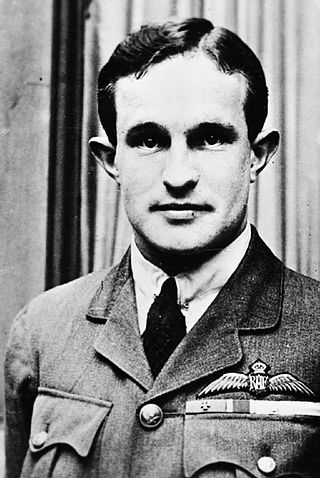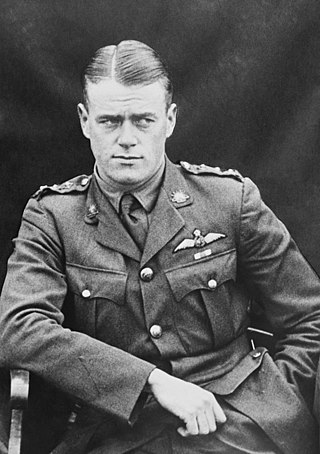William Gordon Claxton DSO, DFC & Bar was a Canadian World War I flying ace credited with 37 victories. He became the leading ace in his squadron.

Andrew Frederick Weatherby (Anthony) Beauchamp-Proctor, was a South African airman and a recipient of the Victoria Cross, the highest award for gallantry in the face of the enemy that can be awarded to British and Commonwealth forces. He was South Africa's leading ace of the First World War, being credited with 54 aerial victories.

Elwyn Roy King, DSO, DFC was a fighter ace in the Australian Flying Corps (AFC) during World War I. He achieved twenty-six victories in aerial combat, making him the fourth highest-scoring Australian pilot of the war, and second only to Harry Cobby in the AFC. A civil pilot and engineer between the wars, he served in the Royal Australian Air Force (RAAF) from 1939 until his death.
Frank Ormond "Mongoose" Soden DFC & Bar was a First World War flying ace and RAF commander during the Second World War.
William McKenzie Thomson MC, DFC was a Canadian First World War flying ace, officially credited with 26 victories while flying Bristol Fighters with 20 Squadron of the Royal Flying Corps and Royal Air Force.

George Augustus Vaughn Jr. was an American fighter ace in World War I and Distinguished Service Cross, Britain's Distinguished Flying Cross, and Silver Star recipient. Vaughn was America's second-ranking Air Service ace to survive the war.
Major Thomas Sinclair Harrison was a World War I fighter ace credited with 22 aerial victories. He was a balloon buster, as he destroyed two enemy observation balloons. This made him the fourth highest scoring South African.

Lieutenant Lawrence Kingsley Callahan was a World War I flying ace credited with five victories.

Thomas Charles Richmond Baker, was an Australian soldier, aviator, and flying ace of the First World War. Born in Smithfield, South Australia, he was an active sportsman in his youth and developed a keen interest in aviation. He was employed as a clerk with the Bank of New South Wales, before he enlisted in the Australian Imperial Force in July 1915, for service in World War I. Posted to an artillery unit on the Western Front, he was awarded the Military Medal for carrying out numerous repairs on a communications line while subject to severe artillery fire. In June 1917, Baker was awarded a bar to his decoration for his part in quelling a fire in one of the artillery gun pits that was endangering approximately 300 rounds of shrapnel and high explosive.

Roy Cecil Phillipps, MC & Bar, DFC was an Australian fighter ace of World War I. He achieved fifteen victories in aerial combat, four of them in a single action on 12 June 1918. A grazier between the wars, he joined the Royal Australian Air Force (RAAF) in 1940 and was killed in a plane crash the following year.
Brigadier Charles Gordon Ross was a career soldier who served in both the Royal Air Force and the South African Air Force. He was a quadruple ace, being credited with 20 victories during World War I.
Lieutenant Edgar George Davies was a British World War I flying ace credited with ten aerial victories.
Lieutenant Henry Coyle Rath DFC was a Canadian World War I flying ace credited with twelve aerial victories.
Captain Reginald Carey Brenton Brading was a British World War I flying ace credited with thirteen confirmed aerial victories.
Lieutenant Gavin Lynedoch Graham DFC, LdH, CdG was a South African World War I flying ace credited with thirteen confirmed aerial victories.

Captain Henry Robinson Clay, Jr. was a World War I flying ace credited with eight confirmed aerial victories.
Second Lieutenant Francis James Ralph was a British World War I ace credited with 13 confirmed aerial victories over German fighter aircraft while flying as an aerial observer.
Roby Lewis Manuel, with Bar, was an Australian flying ace of the First World War credited with 12 official aerial victories. He led the Anzac Day flyby in London in 1919. When World War II erupted, Manuel joined the Royal Australian Air Force and once again served his nation.
Captain Alexander Beck was an Anglo-Argentine aviator during World War I. He was an underage enlistee who went on to become a flying ace credited with 11 official aerial victories.
Wing Commander William Roy Irwin was a Canadian-born World War I flying ace credited with 11 aerial victories. In the process of becoming an ace, he rose as far as the rank of captain. During World War II, he returned to service, reached the rank of Wing Commander, and won an OBE.




